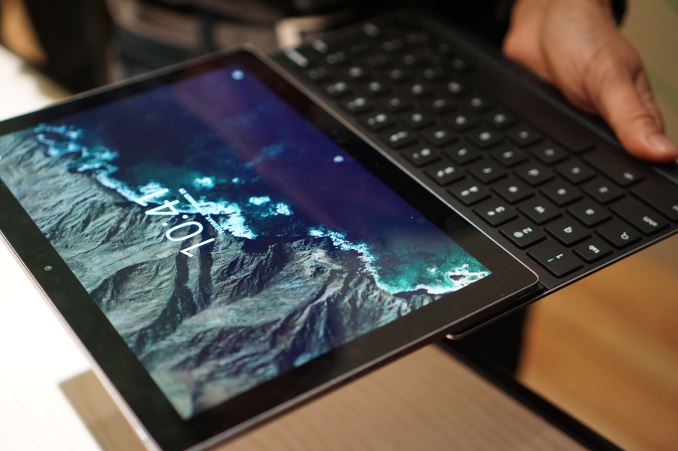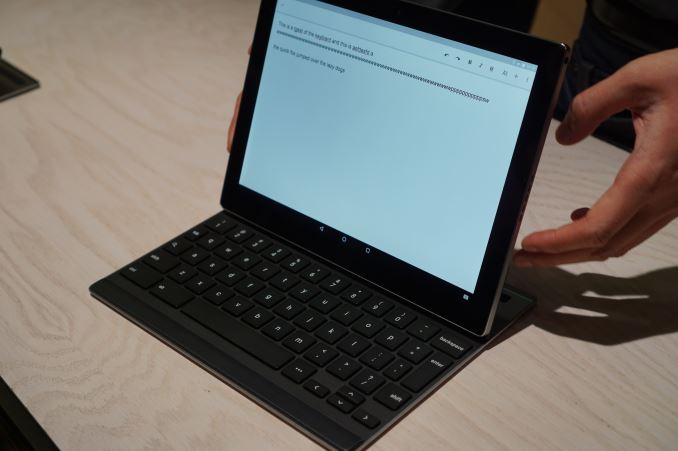Google Announces The Pixel C Tablet
by Brandon Chester on September 29, 2015 6:45 PM EST
In addition to the new Chromecast devices and new Nexus phones, Google gave the world a sneak preview of a new Android tablet which they call the Pixel C. Like the Chromebook Pixel, the Pixel C is designed completely in-house by Google, and it shares many attributes with the Chromebook Pixel even though it runs Android rather than Chrome OS. The hardware is also very interesting, and while there are many unknown details about the Pixel C, what is known looks promising.
As far as specifications go, the Pixel C has a 10.2" IPS display with a resolution of 2560x1800, which equates to a pixel density of 308ppi. Google states that the tablet's aspect ratio is the square root of two, and that's pretty much accurate as 2560/1800 is around 1.42. Representatives at the event stated that the display uses an LTPS backplane rather than an a-Si one, which allows for higher brightness and greater efficiency. Manufacturing LTPS displays at this size costs a considerable amount and it seems that Google felt it was necessary in order to achieve their 500 nit brightness.
As for color, Google advertises that the display covers the sRGB color gamut. I stated this in my live blog, but it's worth repeating that gamut coverage is only loosely correlated with color accuracy. The 2015 Chromebook Pixel covers the sRGB gamut, but is significantly less accurate than a laptop like the MacBook or the QHD+ XPS 13. Based on what I saw at the event, Google has put effort into making sure their new Nexus devices are well calibrated. However, they've also shown lacking effort in doing the same for their $1000 Pixel-branded laptop. I'm very interested to see how accurate the Pixel C's display is, and I'm hopeful that it can stand alongside the new Nexus smartphones and the Nexus 9 when color accuracy is considered.
Inside the Pixel C is NVIDIA's Tegra X1 SoC. Built on TSMC's 20nm process, the X1 packs a quartet of ARM Cortex A57 cores backed by 2MB of L2 cache, and another four A53 cores backed by 512KB of L2 cache, with NVIDIA balancing between performance and power efficiency. Meanwhile the GPU is a 256 core Maxwell implementation that should more than give other Android tablet SoCs more than a run for their money judging from what we've seen in other X1 devices.
It's hard to guess what we're dealing with in terms of clock speeds and TDP, as this is the first time that X1 has shown up in a mobile device. Ryan and Josh have done some previous analysis of X1, and so far the X1 has only been used in the SHIELD Android TV review, an Android TV console built to service 4K video playback and 1080p(ish) native gaming. Compared to the set-top Android TV, performance will obviously differ in a power and thermally constrained situation like a tablet - though by how much remains to be seen - and in any case the X1 remains as one of the most powerful Android tablet SoCs on the market at this time.
While launching the first Tegra X1 mobile device is quite a big announcement, the focus of the Pixel C is actually on the keyboard accessory that you can purchase for it. For Google, the Pixel line has always had a focus on providing users with great build quality, great keyboards, and great trackpads. The Pixel C is no exception, as it has a new bluetooth keyboard accessory designed to work specifically with it. While Apple and Microsoft have opted for soft keyboard covers, Google has decided to make their keyboard accessory out of the same aluminum as the tablet's chassis. This means that there really aren't any compromises as far as key feeling, size, and travel distance are concerned. The keyboard really looks and feels like a slightly condensed version of the Chromebook Pixel's keyboard, with only the lesser used keys around the edges being less than full size.
Almost as important as the keyboard itself is how it works with the tablet. Some devices use a kickstand, while others use the cover itself for support by folding. Google decided to come up with their own way, and when you see it in person you can't help but admire its elegance. The keyboard cover attaches to the tablet magnetically. You can store it on the front to make it like a folded laptop, or on the back when you just want to hide it. When it's on the back you can simply pull the tablet to one side, which shifts the magnetic connection and allows you to elevate the tablet and use it just like a laptop. It's really difficult to describe, but it works incredibly well and allows for a tilt range from 100 to 130 degrees without any sort of kickstand.
Since the keyboard connects via Bluetooth, it does need to be recharged. However, Google has come up with a method of doing so that is as elegant as the keyboard itself. While it's attached to the face of the tablet the small internal keyboard battery is charged inductively by the tablet itself. Having it in that position for only a few minutes a day allows it to stay charged perpetually, and the battery will last up to two months on a single charge. It's just a really ingenious solution and I'm really impressed by it.
The Pixel C is the next device in an emerging category of tablets that sit between your traditional tablet and traditional laptop. How users will respond is anyone's guess, but the Pixel C isn't priced at the extreme high end of the market like Chromebook Pixel is so it should be more accessible to consumers. On the subject of price, the Pixel C will start at $499 for 32GB, and $599 for 64GB, with the keyboard being a $149 accessory.



















58 Comments
View All Comments
Wolfpup - Wednesday, September 30, 2015 - link
I'm more interested in how *dim* the backlight can get than in how bright. I'd expect any modern tablet to get plenty bright, but unfortunately most don't get dim enough for use while reading in the dark-a massive, obvious oversight.iOS devices get pretty dark, and reading programs in them let you get darker still (possibly through contrast tricks, I'm not sure, but they easily beat anything else I've seen).
Bragabondio - Wednesday, September 30, 2015 - link
I use screen filter on Android (works great for reading in bed)galfert - Thursday, October 1, 2015 - link
That's is all great. But how much does it weigh???????Impulses - Thursday, October 1, 2015 - link
With MS having gone back to x86 and properly fixed the vanilla Surface, I just don't see a justification for $400+ tablets that run a mobile OS. They haven't even addressed proper multi window multi tasking, and iOS isn't that far ahead either.I say that as an ex ASUS Transformer user and a happy Nexus 7 user. If I HAD to upgrade right now I'd get a 9 but only because it's often $300 on Amazon (not sure how), or failing that I'd get an ASUS Zen.
The iPad has it's niche, probably will for a while although even that has seen stunted growth, dunno how Pro will do... But really high end Android tablets have a pretty tough time excusing their existence IMO.
Last year's N9 keyboard seemed to hint at OS/UI changes that didn't materialize and this looks like part deux. I'm a huge Android fan but I just don't think it scales this way very well.
zodiacfml - Thursday, October 1, 2015 - link
I think this is simply a take on the Surface Pro which is kinda successful despite the price. I see the Pixel C as a slimmer solution to bigger Chromebooks.StrangerGuy - Saturday, October 3, 2015 - link
$670 i3 Surface Pro 3 with full blown Windows vs a $500 Android tablet with a lousy track record of support for tablet apps, geez what a tough decision. Maybe Google should solve the problem of the Android updating mess before they try to dabble in more hardware which appeal will end up being undermined by the same lack of support.amdwilliam1985 - Tuesday, October 6, 2015 - link
Of course we're going for the Pixel C or the iPad Pro. Have used SP3, it's totally overrated. It's probably because I'm too dumb to use it, half of the time I can't figure out whether to use the pen to draw on the virtual keyboard or use my finger. My fat fingers and my eyes have a hard time adjust to the tiny size app/program icons in windows 10 desktop.Android devices have a hard time updating to the latest OS, because you need the latest version of OS to run apps in the Play store(Nope, most app support 2.3+ or 4.0+). To everyday end user, honestly, they should stick to the OS that were shipped with their devices. Why would you upgrade your iPhone 6 to iOS 9? The biggest feature you'll get is lag. Well, simply because Apple designed iOS 9 with iPhone 6S in mind, not any older devices. My advises to all my non-tech friends, don't do major OS updates, Android or iOS. You'll lose more than you get.
ps: security patches are a totally different story, always recommended.
ps2: my wife will buy the surface pro 4 because she wants the best windows "laptop".
ps3: most of the apps I use are taking advantages of the AppCompat library to bring material design elements back to 2.3+ devices.
ps4: when you look at Android devices, look at their Google Play services version rather than OS version, because that's more important in terms of app compatible. (if you are able to connect to Play Store, you get the Google Play Services automatically)
HisDivineOrder - Monday, October 5, 2015 - link
At least there's no 16GB model to taunt users with absurdly small amounts of available storage.